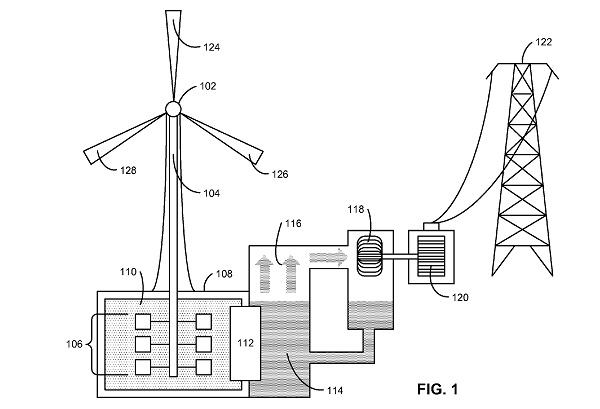There’s no plan to put a wind turbine on the iPhone or iPad, so far as we know – but Apple nevertheless is apparently dabbling in wind power technology.
Apple Insider on Thursday uncovered the company’s June 2011 application with the U.S. Patent and Trademark office for a system intended to store the energy produced by wind turbines.

Here’s how it would work, according to the application:
“During operation, the system uses a set of rotating blades to convert rotational energy from a wind turbine into heat in a low-heat-capacity fluid. Next, the system selectively transfers the heat from the low-heat-capacity fluid to a working fluid. Finally, the system uses the transferred heat in the working fluid to generate electricity.”
In a standard wind turbine, wind moves across blades that are shaped such that the air pressure is uneven on each side of the blades. This causes the blades to spin around a rotor. A rotor shaft turns a series of gears that increase the speed of the rotation, in the process spinning a generator to maximize electricity production.
This has turned out to be one of the more effective ways to produce emissions-free electricity; wind power has grown 40-fold since the late 1990s.
But an issue of concern with wind is that it produces power intermittently, which means that sometimes there’s energy when it’s not needed and sometimes there’s no energy when it is needed. This is mostly a theoretical issue at this point, since wind, despite its growth, remains a relatively small contributor to most grids. Still, many experts – although not all – believe that at high levels of integration some kind of energy storage will be necessary.
The Apple concept is actually pretty simple. The wind turbine turns a shaft that then turns a device (with “one or more paddles, a propeller, a drum, and/or another component”) immersed in a fluid chamber. This action would “agitate, circulate, and/or heat low-heat-capacity fluid.”
That heated fluid could then be held until electricity is needed. Here’s how the application describes the electricity-generating part of the process:
Once sufficient heat is transferred to working fluid, the heat may be used to generate electricity. In particular, the heat may boil working fluid (e.g., due to the low boiling point of working fluid), generating vapor that is used to rotate a turbine. Turbine may then be used to drive an electric generator that supplies electricity to a load, such as a motor vehicle, home, business, building, and/or electrical grid. Transfer of heat from low-heat-capacity fluid to working fluid, as well as the resulting generation of electricity from the transferred heat, may be ceased once the energy stored in low-heat-capacity fluid is no longer needed to meet electrical demand.
As Apple Insider noted – and we’ve reported on extensively – Apple has been looking for ways to power its data centers with alternative energy, but the conceptual nature of this storage technology would seemingly make it an unlikely (at best) candidate for use anytime soon. Obviously there would be losses incurred in converting the rotational energy to heat and then using that heat to generate electricity, so a big question that would have to be answered in development and testing would be how the system compares in efficiency and cost to battery storage.